

Mythology. Greek mythology. Greek mythology is explicitly embodied in a large collection of narratives, and implicitly in Greek representational arts, such as vase-paintings and votive gifts.
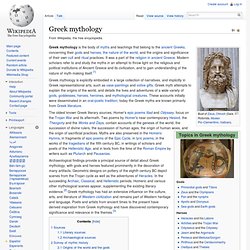
Greek myth attempts to explain the origins of the world, and details the lives and adventures of a wide variety of gods, goddesses, heroes, heroines, and mythological creatures. These accounts initially were disseminated in an oral-poetic tradition; today the Greek myths are known primarily from Greek literature. Archaeological findings provide a principal source of detail about Greek mythology, with gods and heroes featured prominently in the decoration of many artifacts. Geometric designs on pottery of the eighth century BC depict scenes from the Trojan cycle as well as the adventures of Heracles. Sources Literary sources The poetry of the Hellenistic and Roman ages was primarily composed as a literary rather than cultic exercise. Archaeological sources Survey of mythic history Origins of the world and the gods. Pygmalion et Galatée. Un article de Wikipédia, l'encyclopédie libre.
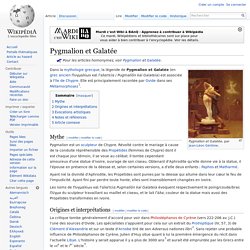
Mythe[modifier | modifier le code] Ayant nié la divinité d'Aphrodite, les Propétides sont punies par la déesse qui allume dans leur cœur le feu de l'impudicité. Ayant fini par perdre toute honte, elles sont insensiblement changées en ivoire. Les noms de Πυγμαλίων καὶ Γαλατεία Pugmalíôn kaì Galateía évoquent respectivement le poing/coude/bras Πύγμα du sculpteur travaillant au maillet et ciseau, et le lait Γάλα, couleur de la statue mais aussi des Propétides transformées en ivoire. Origines et interprétations[modifier | modifier le code] La critique tombe généralement d’accord pour voir dans Philostéphanos de Cyrène (vers 222-206 av. Ce mythe, relié à celui des Propétides, condamne en fait l’indépendance de mœurs des femmes, déjà à l’époque associée à la prostitution ou la sorcellerie, par contraste avec la fidélité de la statue, création de l’homme qui l’a modelée, seule digne d’amour et récompensée en prenant vie[5].
Littérature Peinture Sculpture. Ancient Egyptian religion. Egyptian mythology is the collection of myths from ancient Egypt, which describe the actions of the Egyptian gods as a means of understanding the world.
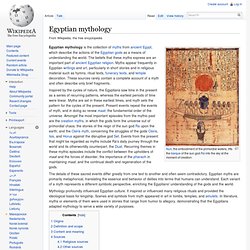
The beliefs that these myths express are an important part of ancient Egyptian religion. Myths appear frequently in Egyptian writings and art, particularly in short stories and in religious material such as hymns, ritual texts, funerary texts, and temple decoration. These sources rarely contain a complete account of a myth and often describe only brief fragments. The details of these sacred events differ greatly from one text to another and often seem contradictory. Egyptian myths are primarily metaphorical, translating the essence and behavior of deities into terms that humans can understand. Mythology profoundly influenced Egyptian culture.
Origins[edit] The development of Egyptian myth is difficult to trace. Another possible source for mythology is ritual. Definition and scope[edit] Anubis. Anubis (/əˈnuːbəs/ or /əˈnjuːbəs/;[2] Ancient Greek: Ἄνουβις) is the Greek name[3] for a jackal-headed god associated with mummification and the afterlife in ancient Egyptian religion.
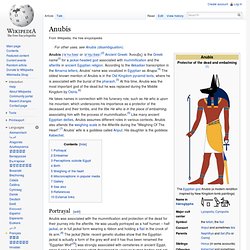
According to the Akkadian transcription in the Amarna letters, Anubis' name was vocalized in Egyptian as Anapa.[4] The oldest known mention of Anubis is in the Old Kingdom pyramid texts, where he is associated with the burial of the pharaoh.[5] At this time, Anubis was the most important god of the dead but he was replaced during the Middle Kingdom by Osiris.[6] He takes names in connection with his funerary role, such as He who is upon his mountain, which underscores his importance as a protector of the deceased and their tombs, and the title He who is in the place of embalming, associating him with the process of mummification.[5] Like many ancient Egyptian deities, Anubis assumes different roles in various contexts.
Portrayal[edit] Embalmer[edit] Perceptions outside Egypt[edit] Myth of Osiris and Isis. From right to left: Isis, her husband Osiris, and their son Horus, the protagonists of the Osiris myth, in a Twenty-second Dynasty statuette The Osiris myth reached its basic form in or before the 24th century BCE.

Many of its elements originated in religious ideas, but the conflict between Horus and Set may have been partly inspired by a regional struggle in Egypt's early history or prehistory. Scholars have tried to discern the exact nature of the events that gave rise to the story, but they have reached no definitive conclusions. Jewish mythology. Jewish mythology is the sacred and traditional narratives that help explain and symbolize Judaism.

Elements of Jewish mythology have had a profound influence on Christian and Islamic mythology, as well as world culture in general. Christian mythology directly inherited many of the narratives from the Jewish people, sharing in common the narratives from the Old Testament. Golem. Un article de Wikipédia, l'encyclopédie libre.
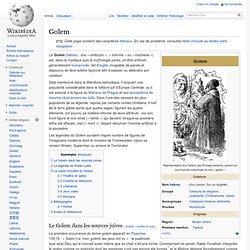
Golem Représentation d'un Golem, par Philippe Semeria, portant sur son front les consonnes du mot « golem ». Créature Origines Le Golem (hébreu : גולם « embryon », « informe » ou « inachevé ») est, dans la mystique puis la mythologie juives, un être artificiel, généralement humanoïde, fait d’argile, incapable de parole et dépourvu de libre-arbitre façonné afin d’assister ou défendre son créateur.
Déjà mentionné dans la littérature talmudique, il acquiert une popularité considérable dans le folklore juif d’Europe Centrale, où il est associé à la figure du Maharal de Prague et aux accusations de meurtre rituel envers les Juifs. Les légendes du Golem auraient inspiré nombre de figures de l’imaginaire moderne dont le monstre de Frankenstein (dans sa version filmée), Superman ou encore le Terminator. Personal mythology.